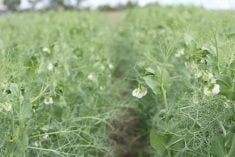Cull cow prices have nearly reached pre-BSE levels, giving producers a little more financial breathing room.
“Thank goodness,” said Heini Hehli of Rimbey, Alta.
Hehli has shipped five or six cull dairy cows over the past six months, and the prices were surprisingly good at 45 to 52 cents a pound. On an 1,800 lb. dairy cow, that translates to $800 to $900 a cow.
“For us, the cull cows are the byproduct and it’s a nice little bonus,” he said.
Read Also

Prairies have variable soil moisture conditions
The dry weather in the west was welcome for preserving grain quality and advancing harvest, but it has resulted in very dry soil moisture conditions.
“We replace 10 to 30 percent of cows a year, so it’s a substantial income.”
The average price for a D1, D2 cows in Alberta in March was $52.83 per hundredweight and reached $59.84 in the week ending April 23. The last time prices reached that level was May 2003, just before BSE was discovered in a northern Alberta cow.
Prices dropped dramatically after that, hitting $11.91 per cwt. for D1, D2 cows in August 2003.
Hehli said his cull dairy cows never fetched much more than $200 per head after BSE.
“It’s quite a difference,” he said. “It helps the replacement costs for calves to be raised.”
Brian Perillat, senior market analyst with Canfax, said high cull cow prices are a combination of seasonal short supply, increased demand for hamburger and low imports of beef into North America.
“This time of year is always a peak, but prices are pretty much at pre-BSE levels,” Perillat said.
“It may be a couple cents under, but it’s pretty darned close. It’s low supply, low import and increasing demand.… The American trim prices are driving this. There is less trim coming into North America.”
Perillat said the high Canadian dollar is keeping Canadian cattle prices lower than those in the United States.
“The whole beef thing looks exciting, but the dollar wipes all that advantage away from us.”
Marty Gilfillan with the Grande Prairie Livestock Market in Grande Prairie, Alta., said higher prices have enticed some producers to take a break from calving and take cattle to market.
“We’ve had a decent number of cows coming in,” he said.
“It’s nice to have some positive good prices in the system.”
He said the higher prices are a result of a triple combination.
“The demand is good for the hamburger, the number of cull cows are reducing and it’s a timing thing too.”
Feeder cattle prices also aren’t too bad, he said, and the fats are at the upper end of the price range.
Graham Schetzsle of Dryland Cattle Trading in Veteran, Alta., said higher prices are luring producers to deliver.
“Anyone who has cows around is making an effort to get them to town,” he said.
Schetzsle said he’s not sure how long the good prices will hold, but expects them to be strong into late June and early July.
“It’s a number game and seasonal thing.”














